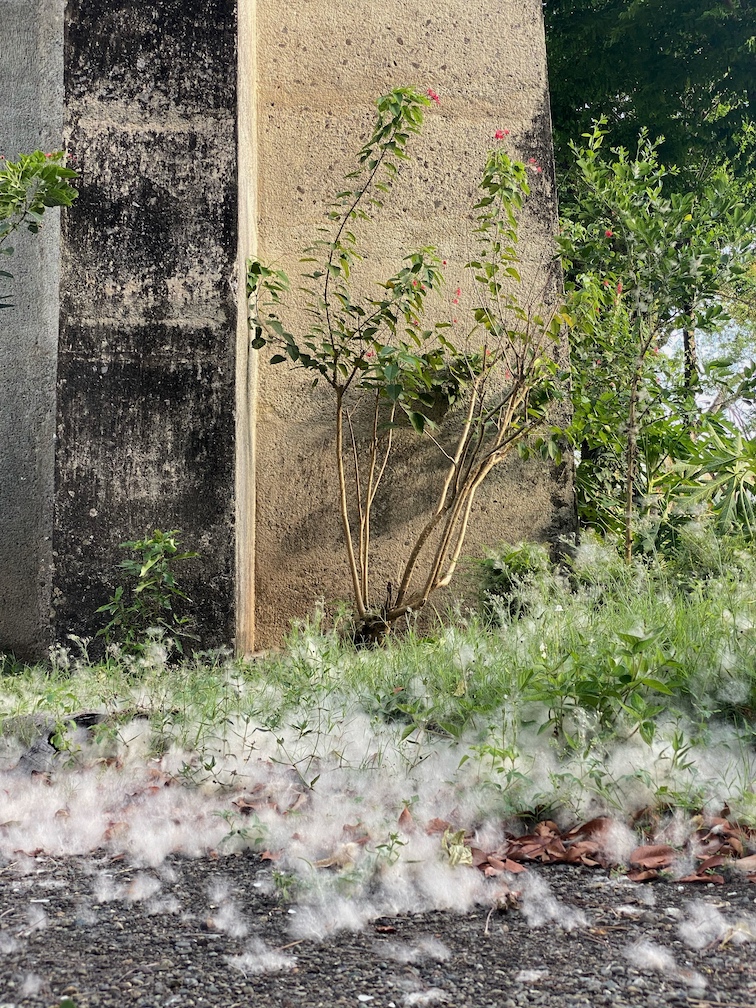
I saw someone die. It was a Monday evening. April 4. A motorcycle accident. I was on my bike, about to buy food, when I saw a large crowd gathered just past the church, where they were holding a singing contest. Behind me, I heard the voice of a young girl singing a song I can’t seem to remember, drowning the cries of the middle-aged woman who was trying to punch a man standing beside a motorcycle. A younger man held her. Hugged her.
In front of them sprawled a body. Lifeless. No breathing. Blood spattered on his face, dripping on hot cement.
I got off my bike and from afar, I heard a siren wailing. Blue and red lights flickered in the air.
The next morning, someone I knew died of diabetes complications. When I went home to continue reading Scott Barry Kaufman’s book Transcend, he started talking about death.
Outdoors in Elbi, the ground was filled with kapok. April started out with me contemplating my inevitable mortality.
Everything is Fleeting
Kaufman said that these “hopefully” occasional brushes with death are—surprisingly—good for one’s mental health. People who experience them, especially those who encounter them in aging, realize that what is truly important in life are not the ups, the peak experiences that are so rare and yet so venerated. What is truly meaningful are plateau experiences: The ray of light that enters one’s bedroom as the day starts. The chirping of birds at the park. A kiss from a toddler.
These experiences are less remembered than their more extravagant cousins. But this is the exact reason why they are more valuable.
This appreciation of the little things in life does not come easy especially when one is young and filled with unquenchable ambition. There is a need to go after things when one is in his early 20s. A restless itch to do. An itch that makes it unbearably difficult to stop. And when one cannot stop, we don’t expect him to notice what is there, around him. The bees jumping from one flower to the next are all but an invisible spectacle.
Seeing the value of plateau experiences comes only after several brushes with death and suffering—experiences, which make one wiser.
I love this description of wisdom in Kaufman’s book:
Wisdom tends to increase with age and is most common among those with high levels of openness to experience, the capacity for self-examination and introspection, a motivation for personal growth, and the willingness to remain skeptical of one’s self-views, continually questioning assumptions and beliefs, and exploring and evaluating new information that is relevant to one’s identities.
This skepticism, this continuous challenging of one’s strongly held views, this drive to seek the truth, are marks of wisdom. And here is where I see the real connection between plateau experiences, brushes with death, and wisdom: When one wants to see the world as it really is, driven by curiosity and truth-seeking, one easily realizes that everything is fleeting. Curiosity opens one’s eyes and lets one see the meaning behind all the deaths and suffering around.
If I have not been practicing meditation, if I have not been writing in my journal every day, if I have not been contemplating the meaning of life, I would have been there at the spot where that man died that April evening and would not have cared one bit about what it means to me or to those I love.
This practice of looking closer at things and then seeing their transience opens one’s eyes to their preciousness—preciousness that generates gratitude and awe. Gratitude for a gift that we never really asked for but was given to us. Awe for the realization that of the many possible existents, it is us who are breathing, here, now as if we were chosen. From all of these arises the motivation to live life as intentionally as possible.
Part of encountering one’s mortality is realizing how little time one has to do what one needs to do.
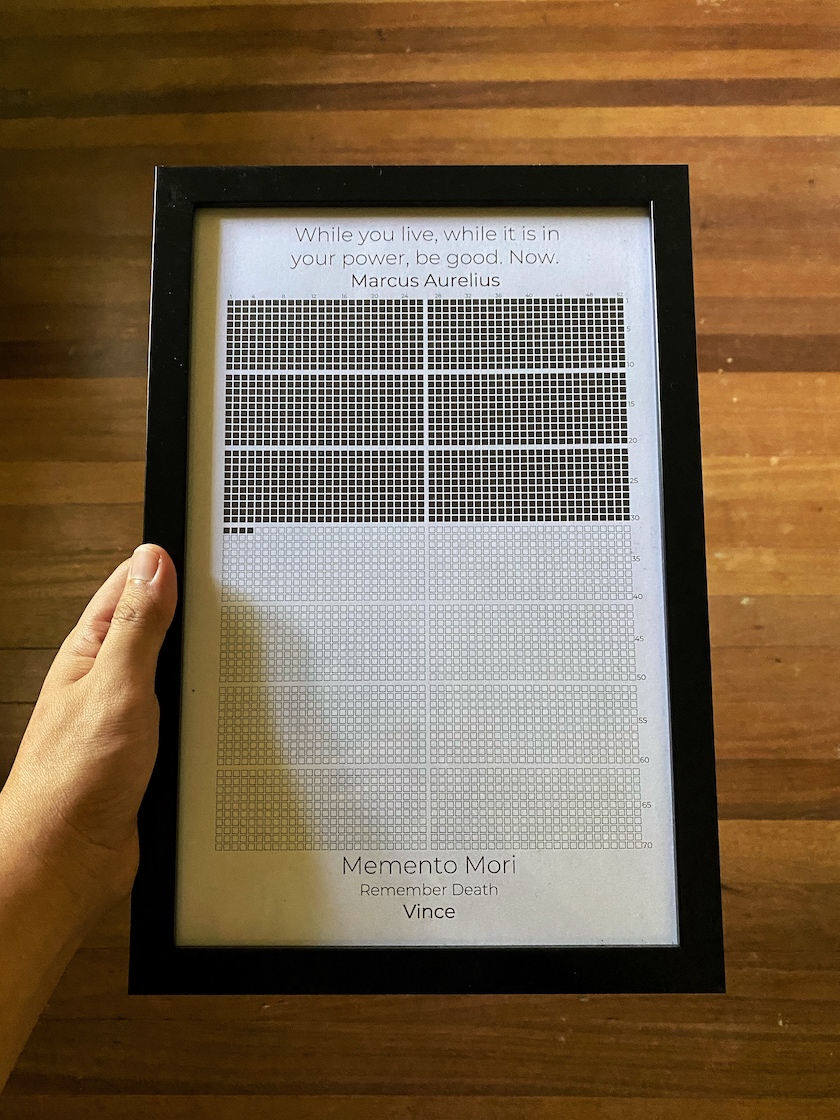
Last month, I bought this decent memento mori calendar. Memento Mori is Latin for “remember death.” Each square symbolizes a week of my life. Shaded squares are weeks I have consumed. Unshaded squares are weeks left for me to use if I’m lucky enough to reach 70. I am in the middle years of my life. If the universe is good, I can still have twice the weeks I have already consumed and some extra. What will I do with the remaining weeks of my life? That is what troubles me.
It is a question, that Paddleton, a film I watched this April and loved very much, answered beautifully in one simple scene.
Michael and Andy were neighbors who became really close friends. Both lived alone. When Michael learned that he would die of cancer and that doctors could no longer do anything, he decided to take his own life via pills prescribed by a physician. He asked for Andy’s help, which led to a six-hour road trip to get the pills.
A few weeks after the road trip, Michael and Andy were sitting on their couch, watching the same movie they watch every night when Michael suddenly spoke. “I think I’m ready,” he said. Andy turns to him surprised and a bit confused. “I want to go when I feel good. I don’t want to go when it’s hurting,” continued Michael. Andy bargains a little but Michael repeated firmly, “I think I’m ready.”
Andy surrenders, looks back at the TV, looks up, gave a sigh, and said, “I should have took off from work. I should have took off. A month ago. We could’ve done more stuff. I wish I had done that.”
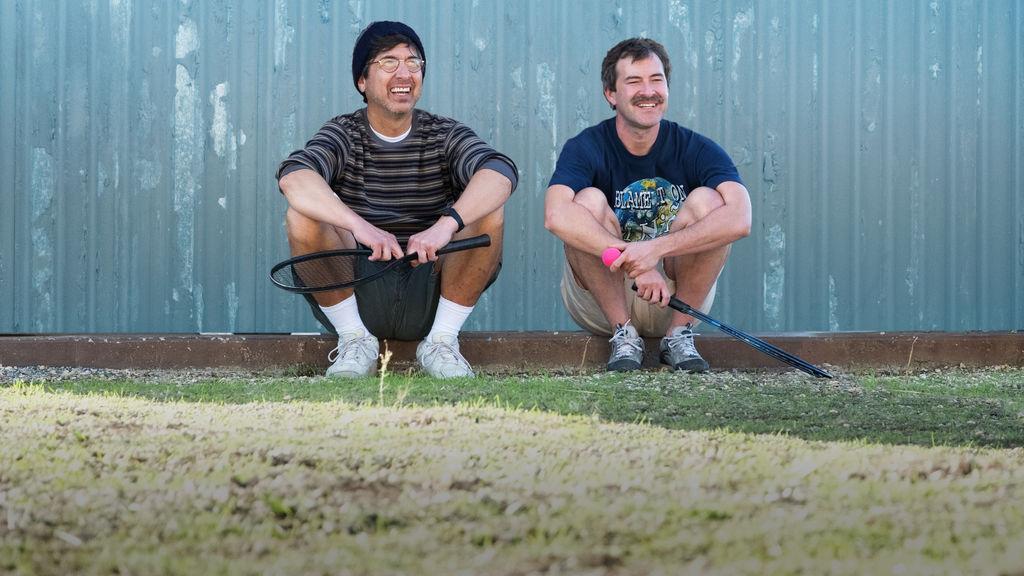
Where Are All These Things Going?
In one journaling session this April, I started listing the intermediate creative artifacts I regularly produce during my daily creative routine: permanent notes, field notes, quotes, narratives, translations, poems, vignettes, photographs, etc. Most of them are collected inside my Talahardin, my note-writing system. For some reason, the question came to me, “Where are all these things going?”
I mean, what’s the point? What’s the point of accumulating all this stuff? That was when an even more important question arrived, “What do I really want to do with the little time I have left in this world?”
It’s not like I haven’t asked this question before. It’s just that I have never felt the question this strong.
The most natural answer to this question, of course, is books. I have been fantasizing about writing a book since I was in grade school. Back then it was a graphic novel. I called it Ilaya, a fantasy story set in a high fantasy world of diwatas, inspired by watching Mulawin and Encantadia.
Books occupy a significant amount of space at home. I have collected books throughout my adult life. I read books for a living. I call myself a writer. Most of the people I admire are authors. There are lots of things I am unsure of in this half-filled life—but writing a book is something I am 100% sure I want to do before it all ends.
And so, this month, after giving it much thought, I have silently declared to myself—and perhaps publicly declare here, for the first time—that I am starting a book project. A “real” book project. Not the ebook projects I did in the past.
This is good. I’m gaining traction just by making up my mind. This is bad. Where do I start?
The Book I Want to Write
The most natural start is to think about what kind of book I want to write, which is the same as asking what kind of writing I want to write.
I journaled further on this and discovered that I wanted to give birth to beautiful non-fiction books with photographs that combine personal narratives, philosophical thinking, cultural references, and historical descriptions all situated in a specific geographical location. In short, given my wide and sometimes sporadic interests, I couldn’t just write a book with a single lens. I need multiple lenses to write it. This will make sure that the book will be a fun project to commit to.
I went back to those intermediate writing artifacts I mentioned above. Then I mapped out a workflow that turns them into blog posts, newsletters, then later, books. I also wrote about what needs to happen daily, weekly, and monthly which would give me more chances of producing a book. None is final at this moment, and I have to go back to the plan. But I have looked at this closely enough to convince myself that this really matters to me right now.
To think better about these intermediate packets, I transferred my entire Talahardin from Craft to Obsidian. Obsidian just gives me more freedom in managing my notes and it allows me to think better about them in a way that Craft, beautiful as it is, is not really designed to do. It was a good 1 and 1/4 years of using it but I am ready to use a better tool to help me focus on really embracing a writing life centered on producing books.
But even more important than the tool is the internal system that the tool follows. Because I would like to write stuff that mixed different kinds of material, I decided to categorize my notes into specific types using tags: Narratives, Quotes, Poetry, PermanentNotes, Translations, FieldNotes, etc.
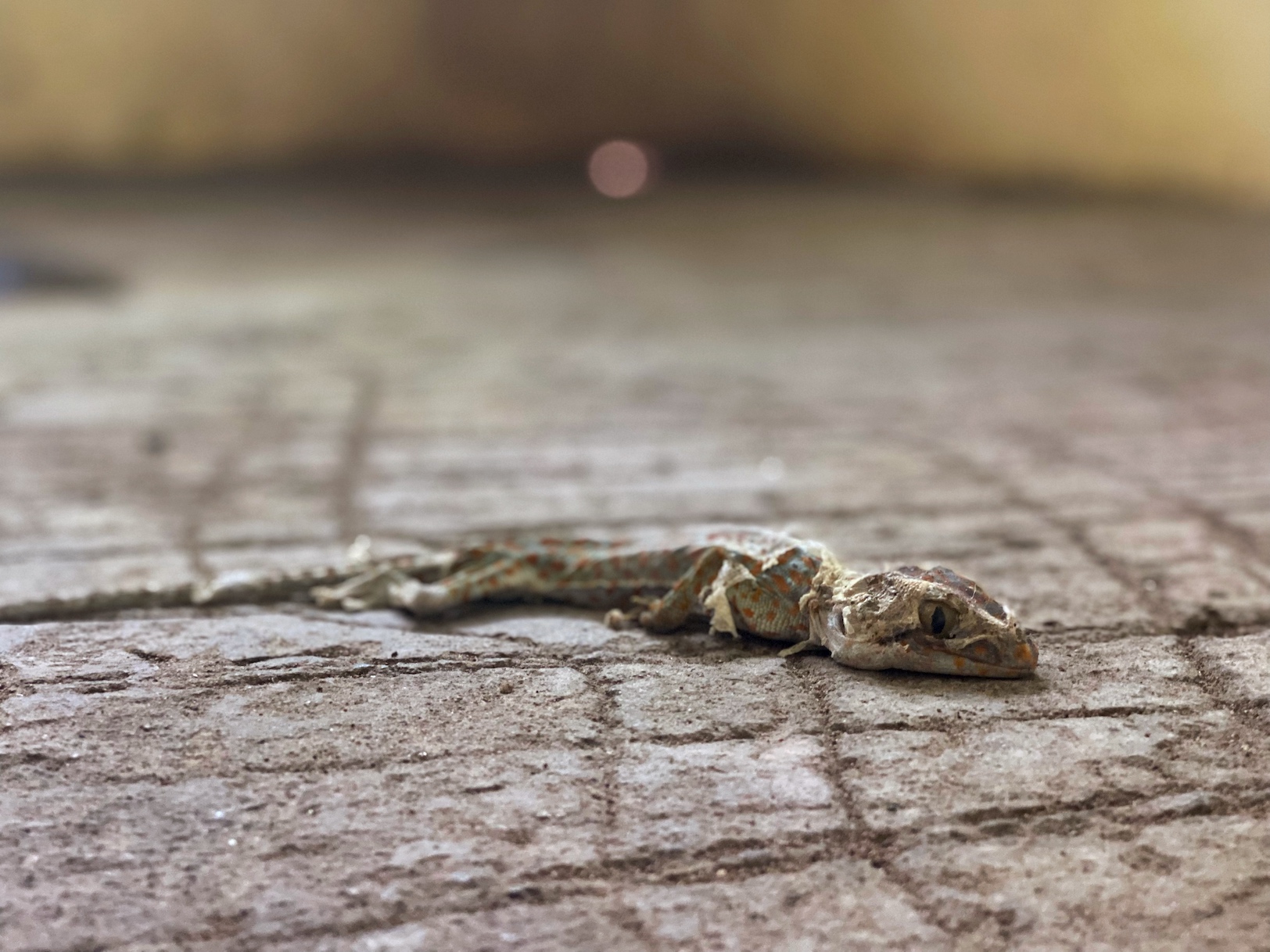
Nature and Place-based Writing
After I finished setting up the organization system just enough, I started playing around with writing narratives. I wrote a vignette on the death of a tuko in my house. I wrote the piece in Filipino after receiving feedback from my girlfriend that I sound like myself more in Filipino. Of course, deciding on the language I use to write will always be a tough decision for me, given the three languages I speak. But writing more in Filipino has always been an option open for exploration. I need to try everything to really hear my voice on the page, and if that means limiting my readership to only those who can understand a certain language, so be it.
I probed further on what kind of writing I wanted to bring to the world. I started drawing a creative family tree, something I saw first in Steal Like an Artist. I placed Thoreau at the center of the tree and then started looking for people I can connect to him. Emerson is obviously above him, although not the focal point of my tree.
I found a book of tributes for Thoreau. It was entitled Now Comes Good Sailing—named after what was said to be his last words. There, I read an essay about Thoreau’s influence on E.B. White, the author of Charlotte’s Web. The essay was basically saying that Thoreau’s influence on White was mainly technical. Their sentence constructions do sound the same in some places, although Thoreau will always be more difficult to understand than White (except in his journals, where he writes more accessibly).
I also started reading Annie Dillard’s book The Writing Life per recommendation by Craig Mod. While reading the first chapter, I noticed that she reads like Thoreau. Her writing is patches of everything: history, anecdotes, intimate personal perspectives. And so I Googled if there is any connection between her and Thoreau. Lo and behold, there is! Not just a tiny thread of connection but a strong tight rope. Turns out, Dillard read Emerson and Thoreau when she was young. As a master’s thesis, she wrote an analysis of Thoreau’s Walden. She even married Robert D. Richardson, Thoreau’s biographer! She loves Walden so much that her magnum opus A Pilgrim at Tinker Creek, which I am currently reading, was her attempt of creating something like Walden—a poetic nonfiction book that ponders the deep questions of existence while at the same time deepening the meaning of a specific place. In her case, Tinker Creek, a body of water in the suburbs where she lived.
However, unlike Thoreau, Dillard wrote her magnum opus while in a library. She wasn’t a naturalist. She was unemployed when she wrote the book. She went out to her backyard and converted it into a wilderness to such skill that people actually thought what she was describing was wilderness! And this is why I love her so much. She is much more relatable, her language much more contemporary than Thoreau’s. I see her as a conduit for me to understand Thoreau better.
I am still in meta-learning mode—establishing my creative family tree and seeing the works I should spend time studying. That said, I know what I am looking for—books and essays about place and nature that talk about what it means to live and draw resources from history, culture, science, philosophy, and every possible source.
Following advice from Craig Mod and Gabriela Pereira, I have started to build a reading list. To come up with a list, I started reading the first few pages and chapters of several highly recommended books:
- A Week at the Concord and Merrimack Rivers by Thoreau
- Desert Solitaire by Edward Abbey
- The Living Mountain by Nan Shepherd
- A Pilgrim at Tinker Creek by Annie Dillard
- Walden by Thoreau
These are books of nature writing but I am also studying the styles of place-based and travel writers like Bruce Chatwin. I found a collection of his essays Anatomy of Restlessness at Booksale and started reading the first two essays. If I changed Uman’s format this month, his essay “I Want to Go to Patagonia” was an inspiration.
Thoreau’s books are difficult to read, which was a surprise because I love his journal so much. It felt as if the person who wrote the books was entirely different from that who wrote the journal. Nan Shepherd’s book was too out of touch, but I might give it another chance later. For now, I shall finish reading A Pilgrim at Tinker Creek and Desert Solitaire.
The decision to read Dillard was a no-brainer. After reading three chapters of the ebook, I was sold. As I said, she is like a more accessible version of Thoreau, who writes the way I want to write. She could do better in terms of conveying philosophical insights in her work, but she tries earnestly and that is enough.
Meanwhile, I decided to read Desert Solitaire after reading an excellent essay by David Gessner entitled “Sick of Nature.” In that essay, Gessner argued that nature writing in its current state has lost most of its original spirit present in books like Walden where a certain quest was the central theme of the work, while nature just happens to be the backdrop where this quest happens. Instead, most contemporary nature writings have been saturated by spiritual language that romanticizes nature rather than honestly depicts it.
I love this essay. It sharpened my criteria for what to include in my reading list. The kind of nature writing I am looking for is exemplified by what Gessner described:
The best writing in this genre is not really “nature writing” anyway but human writing that just happens to take place in nature. And the reason we are still talking about “Walden” 150 years later is as much for the personal story as the pastoral one: a single human being, wrestling mightily with himself, trying to figure out how best to live during his brief time on earth, and, not least of all, a human being who has the nerve, talent, and raw ambition to put that wrestling match on display on the printed page. The human spilling over into the wild, the wild informing the human; the two always intermingling.
Gessner’s essay was enough to convince me to try Edward Abbey’s Desert Solitaire. I’m done with three chapters and really appreciate its down-to-earth voice. The book is also a collection of vignettes that come together to create a narrative. It gave me an idea on how to possibly write and organize a book: If I could write small vignettes slowly and bring them together in a way that creates a narrative, then I have a book.
Aside from these, I also plan to read A River Runs Through It by Norman Maclean (1976), The Rings of Saturn by W.G. Sebald (1995), and Riding Toward Everywhere by W.T. Vollman just to explore their styles.
As much as I wanted to read a similar book written by a Filipino, ideally also in Filipino, I haven’t found one just yet. I went to Mt. Cloud at Baguio to look for one but didn’t see any. The closest I saw was written by a foreigner who spent a year on an island in the Visayas. However, his writing was not what I was looking for. If you know of any such place-based writing set in a specific geographic location in the Philippines, which is brave enough to cross-pollinate personal narrative with other types of materials, ideally written by a Filipino, please send it my way.
While reading all of these books about nature, a common practice among the authors emerged: Everyone described specific moments of deep observation of particular phenomena in nature. Thoreau and Dillard wrote these observations in their journals. I would wager that most nature writers keep field notes and journals. Because of this, I was inspired to go back to writing field notes during my walks, which I rewrite as vignettes in my journal. Here’s a recent example, which I wrote in Filipino:
Pababa na ang araw pero maliwanag pa rin. Maputlang kunti ang sinag nito. Hindi matapang na orange. Mainit sa balat.
May mga nahulog na mangga. Meron ding mga pirasong halatang binalatan. Kinain. Walang mga prutas sa mangga na nasa tapat ng mga ito. Galing ba ang mga ito sa puno? O nahulog ng nakabisikletang dumaan?
Malamig ang simoy ng hangin. Kahit na hindi naman natuloy ang pinakaaasam na ulan kanina. Masarap huminga rito. Malamig at magaan ang hangin. Para akong hinihele.
May mga tanim na okra sa harapan ko. Pero tila napabayaan na sila. Nilamon ng mga gumagapang na halaman. Pinayuko. Malalaki at matatanda na ang mga bunga ng okra. Lupa na at hindi tao ang kakain sa kanila.
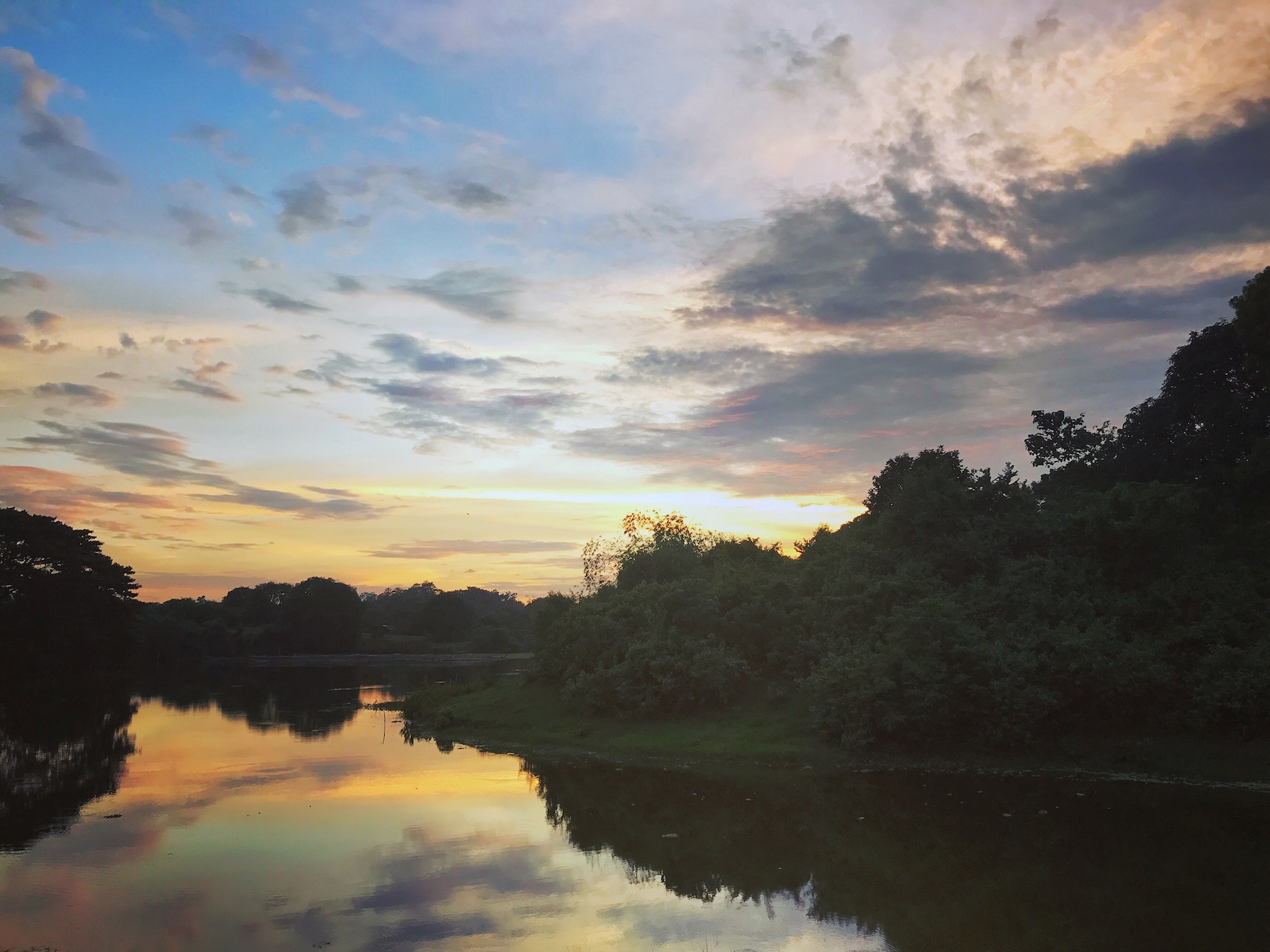
All of these. This intentional remembering of the shortness of my life. This commitment to write a book. And before that, to read my predecessors. I see all of these as a manifestation of courage. The courage to claim who one is.
I am a writer. Not everyone will agree. But not everyone matter.
This is what I want to do. Probably not forever since I am more than this. But that’s okay. For now, I claim what I am sure of.
Everything is fleeting. I have consumed half the number of my weeks. I might as well go out for a walk now, and come back home later to my office to write about it.
What else should I do?